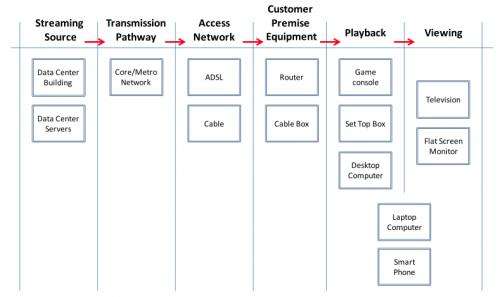Study highlights growing energy impact of internet video streaming

(Phys.org) —How much CO2 was emitted when you streamed that movie from Netflix last night? It's a question few people think about, but now researchers at Lawrence Berkeley National Laboratory (Berkeley Lab) have analyzed the energy usage of home movie viewing. They found that transmitting the bytes across the Internet accounts for the bulk of energy usage and emissions when streaming videos.
In 2011, the year that they studied, Americans streamed 3.2 billion hours of video, which consumed 25 petajoules of energy (enough to power about 175,000 U.S. households for one year) and emitted 1.3 billion kilograms of CO2. More than half of the energy usage went to data transmission, according to the study by Arman Shehabi of Berkeley Lab and Ben Walker and Eric Masanet of Northwestern University. Their study, "The energy and greenhouse-gas implications of internet video streaming in the United States," was published online recently in Environmental Research Letters.
"There's going to be an explosion in the amount of movie streaming," Shehabi said. "What's happened between 2011 and now is like earth and sky. And on top of so many more videos being streamed, the videos themselves are getting more complex and requiring faster streaming rates. We want to highlight that greater efficiency of the network will be needed to offset this huge demand in bandwidth."
The researchers used a life-cycle assessment approach to estimate energy usage and greenhouse gas emissions associated with streaming videos, and compared it to the energy and emissions associated with watching movies on traditional DVDs. They found both activities to consume about the same amount of energy if DVDs were mailed. However, if consumers drove to the store to rent or purchase the movie, that significantly increased energy consumption. Streaming benefits from removing the need for inefficient DVD players, but those gains are canceled out by the addition of network energy.
As movie rentals increasingly shift away from DVDs towards streaming, understanding the network's energy efficiency becomes ever more important. "We have more than a decade of research on the energy efficiency of data centers, but on the data transmission part there have not been a lot of studies on how much energy is being used," Shehabi said.
He pointed out that as videos are streamed across the Internet they pass through different parts of the network. A different company often owns each part, and the details of how their networks operate are often kept confidential for proprietary reasons.
"We want this to be a call to industry," Shehabi said. "Network infrastructure is going to greatly expand in the near future to meet the upcoming demand in video steaming. Let's get more data out there on how much electricity is actually being used and make sure that energy efficiency is a priority in this expansion."
The research used an open-source model developed at Berkeley Lab with funding from Google. Called the Cloud Energy and Emissions Research (CLEER) Model, it is open to the public and allows anyone to analyze the energy and carbon impacts of cloud computing.
More information: The study is available online: iopscience.iop.org/1748-9326/9/5/054007/article
Journal information: Environmental Research Letters
Provided by Lawrence Berkeley National Laboratory



















